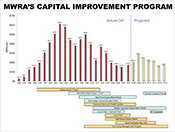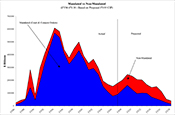| Home |
| Water System |
| Sewer System |
| Harbor and Bay |
| School Program |
| About MWRA |
| Doing Business with MWRA |
| Contact MWRA |
What Drives MWRA's Rates
Massachusetts Water Resources Authority
|
MWRA'S DEBT BURDEN
The biggest driver of MWRA's budget is debt service on the bonds that financed major capital improvement projects.
Since its creation in 1985, MWRA has completed $6.8 billion worth of upgrades to its water and sewer systems
(Figure 1)These projects have all but reversed the effects of neglect and underfunding of the previous decades.
|
With the sewer treatment facilities on Deer Island complete, the clean-up of Boston Harbor has gained national acclaim as one of the greatest environmental success stories of our time. On the drinking water side, massive upgrades to water infrastructure, including a state-of-the-art ozone disinfection plant and covered storage tanks throughout the district guarantee some of the best drinking water in the country for generations to come. But these improvements have come at a price.
Nearly 80% of projects in MWRA's Capital Improvement Program (CIP) have been mandated by state or federal regulations (Figure 2).
|
In the early years of MWRA, repayment of principal on large capital projects was deferred to protect ratepayers from the sudden impact of rapid spending.
MWRA's debt service burden (the share of its budget that is devoted to principal and interest payments on its bonds) now accounts for 58% of the budget.
WHAT IS DEBT SERVICE ASSISTANCE?
In response to a growing public outcry against rising water and sewer rates, the legislature appropriated $20 million in FY1994 for the state-wide Sewer Rate Relief Fund, also known as “debt service assistance.” This amount was enough to offset 20% of debt service for wastewater projects across the Commonwealth. By FY2002, the appropriation had grown to $60 million. MWRA’s share of this funding has averaged 80% over the years. Debt service assistance was designed to offset revenues that would otherwise have to come directly from ratepayers.
In FY2003, the program was eliminated in response to the state's fiscal crisis. This cut represented a 10% reduction in MWRA’s annual revenue in the middle of the year. Over 90% of MWRA’s total revenue is derived from users’ rates and charges. Since FY2004, some funding has been restored, but it is not nearly enough to keep pace with MWRA's increasing debt service. Other than state debt service assistance, MWRA has no impact on the state budget.
For FY2009, the Governo'sr proposed budget includes an appropriation of $15 million for this program.
BUDGET IMPACTS BEYOND MWRA'S CONTROL
A number of economic and regulatory forces can add to the burden on ratepayers, including:
- Rising energy and utility costs,
- Rising interest rates,
- Rising health insurance costs,
- Changes in public health and environmental requirements that increase overall spending costs.
|
KEEPING OPERATING COSTS DOWN
MWRA must continue to find ways to keep costs down and to ensure that every dollar spent provides real public health or environmental benefits.
Scaling back and retooling the workforce, consolidating space and reducing expenses for chemicals, utilities and contract operations have been critical strategies for controlling costs.
- When adjusted for inflation, MWRA's direct operating costs were more than $30 million less in FY2006 than in FY2000.
- MWRA staffing levels have decreased by nearly 30%, or 509 positions, since FY1997 (Figure 3).
- Nine operations and maintenance facilities across the service area were consolidated into one central facility in Chelsea.
- Facilities continue to be automated.
- Operations and maintenance staff have been trained for cross-functionality.
- MWRA's vehicle fleet has been reduced by 10%.
- The Charlestown Navy Yard Headquarters' lease was reduced from 3 buildings to 2.5 floors in a single building.
- Space needs at the Fore River Shipyard have been reduced from 180 acres to 20 acres; the sale of the last parcel is pending.
- MWRA aggressively manages energy and chemical use at Deer Island:
- MWRA competitively purchases electricity
- To reduce the purchase of power, the plant self-generates up to 25% of its electricity
- MWRA participates in two programs that raise revenues from energy generation.
- Digester gas is recycled for heating in lieu of diesel fuel.
- The use of sodium hypochlorite gas and dechlorination chemicals has dropped steadily since FY2000.
- MWRA has refunded $4.3 billion of debt for present value savings of $165.5 million to date.
Updated August 26, 2008



